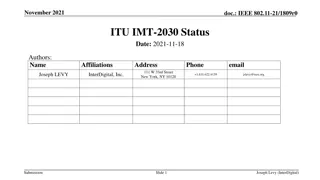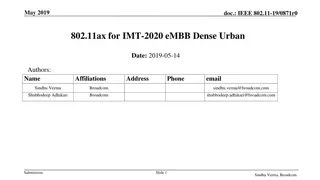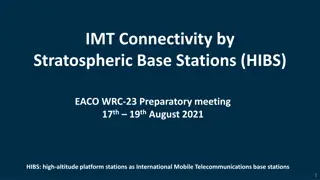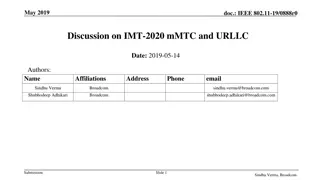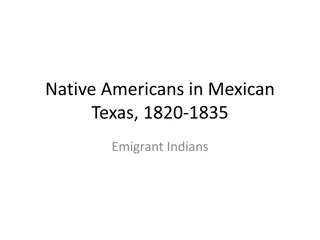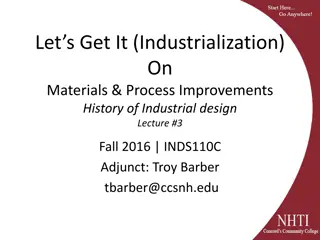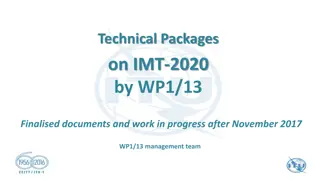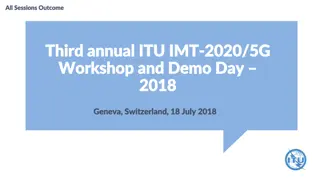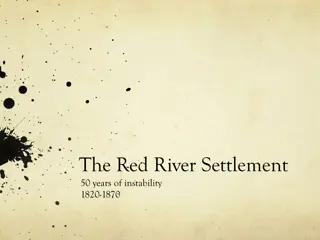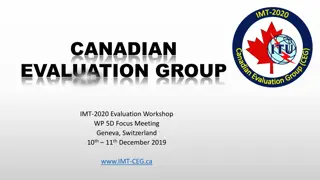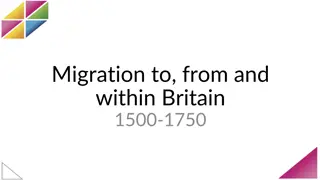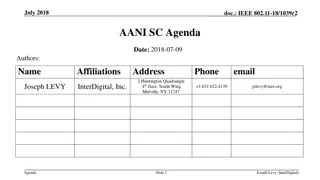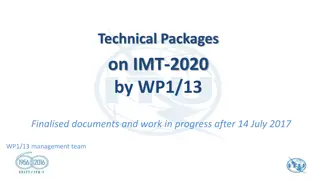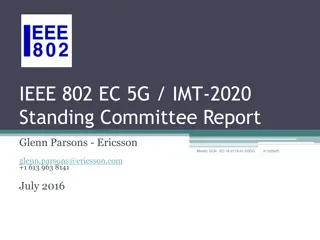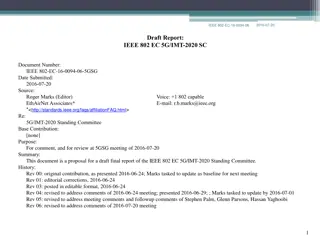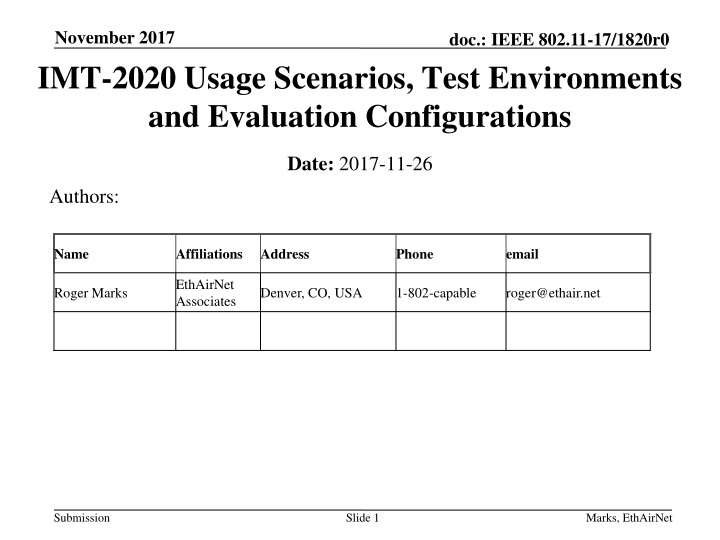
IMT-2020 Usage Scenarios and Evaluation Configurations Overview
Dive into the details of IMT-2020 usage scenarios, test environments, and evaluation configurations as presented in the November 2017 document by IEEE 802.11-17/1820r0. Understand the demands and requirements for a successful IMT-2020 proposal, including enhanced mobile broadband (eMBB), massive machine type communications (mMTC), and ultra-reliable and low-latency communications (URLLC). Explore the defined test environments, evaluation configurations, and the steps involved in assessing compliance with minimum requirements.
Download Presentation

Please find below an Image/Link to download the presentation.
The content on the website is provided AS IS for your information and personal use only. It may not be sold, licensed, or shared on other websites without obtaining consent from the author. If you encounter any issues during the download, it is possible that the publisher has removed the file from their server.
You are allowed to download the files provided on this website for personal or commercial use, subject to the condition that they are used lawfully. All files are the property of their respective owners.
The content on the website is provided AS IS for your information and personal use only. It may not be sold, licensed, or shared on other websites without obtaining consent from the author.
E N D
Presentation Transcript
November 2017 IMT-2020 Usage Scenarios, Test Environments and Evaluation Configurations doc.: IEEE 802.11-17/1820r0 Date: 2017-11-26 Authors: Name Affiliations Address Phone email EthAirNet Associates Roger Marks Denver, CO, USA 1-802-capable roger@ethair.net Submission Slide 1 Marks, EthAirNet
November 2017 doc.: IEEE 802.11-17/1820r0 Abstract This contribution, intended for presentation to the IEEE 802.11 Advanced Access Network Interface Standing Committee (AANI), summarizes the IMT-2020 Usage Scenarios, Test Environments and Evaluation Configurations. It does not attempt to represent the detailed environments, configurations, or technical performance requirements but only to summarize their applicability and some key parameters. A key point is that a successful IMT-2020 proposal must cover a comprehensive and challenging set of demands. Note: This information is reorganized from multiple sources. Errors are possible. Please bring any errors to the attention of ANNI. Submission Slide 2 Marks, EthAirNet
November 2017 doc.: IEEE 802.11-17/1820r0 IMT-2020 Usage Scenarios enhanced mobile broadband (eMBB) massive machine type communications (mMTC) ultra-reliable and low-latency communications (URLLC) Submission Slide 3 Marks, EthAirNet
November 2017 doc.: IEEE 802.11-17/1820r0 IMT-2020 Test Environments A test environment is defined as the combination of usage scenario and geographic environment as described in the draft new Report ITU-R M.[IMT-2020.EVAL]. Note: The quote is from [2]; its reference is to [3]. Test Environments for eMBB [3] Indoor Hotspot Dense Urban Rural Test Environment for mMTC [3] Urban Macro-mMTC Test Environment for URLLC [3] Urban Macro-URLLC Submission Slide 4 Marks, EthAirNet
November 2017 doc.: IEEE 802.11-17/1820r0 Test Environment Requirements [1] IMT-2020 Step 2 ( Development of candidate RITs or SRITs ) [1]: An RIT needs to fulfil the minimum requirements for at least three test environments; two test environments under eMBB and one test environment under mMTC or URLLC. IMT-2020 Step 6 ( Review to assess compliance with minimum requirements ) [1]: the evaluated proposal for an RIT/SRIT is assessed as a qualifying RIT/SRIT, if an RIT/SRIT fulfils the minimum requirements for the five test environments comprising the three usage scenarios. Such a qualified RIT/SRIT will go forward for further consideration in Step 7. Submission Slide 5 Marks, EthAirNet
November 2017 doc.: IEEE 802.11-17/1820r0 IMT-2020 Evaluation Configurations [3] Evaluation configurations are defined for the selected test environments. The configuration parameters shall be applied in analytical and simulation assessments of candidate RITs/SRITs. For the cases when there are multiple evaluation configurations under the selected test environment, one of the evaluation configurations under that test environment can be used to test the candidate RITs/ SRITs. The technical performance requirement corresponding to that test environment is fulfilled if this requirement is met for one of the evaluation configurations under that specific test environment. In addition, for the Rural-eMBB test environment, the average spectral efficiency value should meet the threshold values for the LMLC (low mobility large cell) evaluation configuration with ISD of 6000 m and either evaluation configuration with ISD of 1732 m. Note: This last point is discussed below. Submission Slide 6 Marks, EthAirNet
November 2017 doc.: IEEE 802.11-17/1820r0 Indoor Hotspot-eMBB Evaluation Configurations [3] (selected highlights only; see sources for full details) Configuration A Configuration B Configuration C Inter-site distance 20 m Device deployment 100% indoor (3 km/h) UE density 10 UEs per TRxP (transmission reception point) Carrier frequency 4 GHz 30 GHz 70 GHz Bandwidth (TDD) 20 MHz 80 MHz 80 MHz Number of antenna elements per TRxP Up to 256 Tx/Rx Up to 256 Tx/Rx Up to 1024 Tx/Rx Number of UE antenna elements Up to 8 Tx/Rx Up to 32 Tx/Rx Up to 64 Tx/Rx Submission Slide 7 Marks, EthAirNet
November 2017 doc.: IEEE 802.11-17/1820r0 Dense Urban-eMBB Evaluation Configurations [3] (selected highlights only; see sources for full details) Configuration A Configuration B Inter-site distance 200 m Device deployment 80% indoor (3 km/h), 20% outdoor (in-car, 30 km/h) UE density 10 UEs per TRxP Carrier frequency 4 GHz 30 GHz Bandwidth (TDD) 20 MHz 80 MHz Number of antenna elements per TRxP Up to 256 Tx/Rx Up to 256 Tx/Rx Number of UE antenna elements Up to 8 Tx/Rx Up to 32 Tx/Rx Submission Slide 8 Marks, EthAirNet
November 2017 doc.: IEEE 802.11-17/1820r0 Rural-eMBB Evaluation Configurations [3] (selected highlights only; see sources for full details) Configuration A Configuration B Configuration B (LMLC) Bandwidth (TDD) 20 MHz UE density 10 UEs per TRxP Inter-site distance 1732 m 6000 m Device deployment 50% indoor; 50% in-car 40% indoor, 40% outdoor pedestrian, 20% in-car UE speeds of interest Indoor: 3 km/h; in-car: 120 km/h; 500 km/h for evaluation of mobility in high-speed case Indoor : 3 km/h; Outdoor pedestrian: 3 km/h; in-car: 30 km/h Carrier frequency 700 MHz 4 GHz 700 MHz Number of antenna elements per TRxP Up to 64 Tx/Rx Up to 256 Tx/Rx Up to 64 Tx/Rx Number of UE antenna elements Up to 4 Tx/Rx Up to 8 Tx/Rx Up to 4 Tx/Rx Submission Slide 9 Marks, EthAirNet
November 2017 doc.: IEEE 802.11-17/1820r0 eMBB Mobility Requirements Under Rural eMBB test environment, target values for both mobility of 120 km/h and 500 km/h in Table 4 of Report ITU-R M.[IMT- 2020.TECH PERF REQ] shall be achieved to fulfill mobility requirements of Rural-eMBB test environment. [3] Note: The requirement is not limited to specified configurations. TABLE 4: Traffic channel link data rates normalized by bandwidth [2] Test environment Normalized traffic channel link data rate (Bit/s/Hz) Mobility (km/h) Indoor Hotspot eMBB 1.5 10 Dense Urban eMBB 1.12 30 Rural eMBB 0.8 120 0.45 500 Submission Slide 10 Marks, EthAirNet
November 2017 doc.: IEEE 802.11-17/1820r0 eMBB Average Spectral Efficiency [2] for the Rural-eMBB test environment, the average spectral efficiency value should meet the threshold values for the LMLC (low mobility large cell) evaluation configuration with ISD of 6000 m and either evaluation configuration with ISD of 1732 m [3] TABLE 2: Average spectral efficiency [2] Test environment Downlink (bit/s/Hz/TRxP) Uplink (bit/s/Hz/TRxP) Indoor Hotspot eMBB 9 6.75 Dense Urban eMBB 7.8 5.4 Rural eMBB 3.3 1.6 Submission Slide 11 Marks, EthAirNet
November 2017 doc.: IEEE 802.11-17/1820r0 mMTC Evaluation Configurations [3] key special requirement: connection density: 1 000 000 devices per km2[2] (selected highlights only; see sources for full details) Configuration A Configuration B Carrier frequency 700 MHz BS antenna height 25 m Percentage of high loss and low loss building type 20% high loss, 80% low loss # of antenna elements per TRxP Up to 64 Tx/Rx #of UE antenna elements Up to 2 Tx/Rx Device deployment 80% outdoor, 20% indoor UE density 10 UEs per TRxP Inter-site distance 500 m 1732 m Bandwidth up to 10 MHz up to 50 MHz Submission Slide 12 Marks, EthAirNet
November 2017 doc.: IEEE 802.11-17/1820r0 URLLC Evaluation Configurations: [3] key special requirements: 1-10-5 (five nines) success probability of transmitting a layer 2 PDU of 32 bytes within 1 ms in channel quality of coverage edge for the Urban Macro-URLLC test environment ) [2] 1 ms user plane latency [2] (selected highlights only; see sources for full details) Configuration A Configuration B Carrier frequency 4 GHz 700 MHz #of antenna elements per TRxP Up to 256 Tx/Rx Up to 64 Tx/Rx #of UE antenna elements Up to 8 Tx/Rx Up to 4 Tx/Rx Device deployment 80% outdoor, 20% indoor UE density 10 UEs per TRxP Inter-site distance 500 m Bandwidth up to 100 MHz up to 40 MHz Submission Slide 13 Marks, EthAirNet
November 2017 doc.: IEEE 802.11-17/1820r0 Conclusions and Observations The IMT-2020 process specifies that successful proposals must meet a challenging set of demands in a wide range of extreme conditions: carrier frequency of 700 MHz, etc. mobility of 30 km/h, 120 km/h, 500 km/h, etc. inter-site distance of 500 m, 1.7 km, 6 km, etc. It may be difficult for a single RIT to meet all of the demands. Submission Slide 14 Marks, EthAirNet
November 2017 doc.: IEEE 802.11-17/1820r0 Call to Action Review this content and ensure that it is correct it is derived from the source documents, but it s possible that the author has misunderstood the source If the content is correct, imagine a set of IEEE 802.11 technologies that will satisfy the full set of IMT-2020 requirements Including the detailed requirements, not only the highlights herein Submission Slide 15 Marks, EthAirNet
November 2017 doc.: IEEE 802.11-17/1820r0 References [1] Revision 1 to Document IMT-2020/2 ( Submission, evaluation process and consensus building for IMT-2020 ), 2017-02-27 [2] Revision 1 to Document 5/40-E ( Draft New Report ITU-R M.[IMT- 2020.TECH PERF REQ]: Minimum requirements related to technical performance for IMT-2020 radio interface(s) ), 2017-02-22 [3] Revision 1 to Document 5/57-E ( Draft New Report ITU-R M.[IMT- 2020.EVAL]: Guidelines for evaluation of radio interface technologies for IMT-2020 ), 2017-10-17 Submission Slide 16 Marks, EthAirNet

